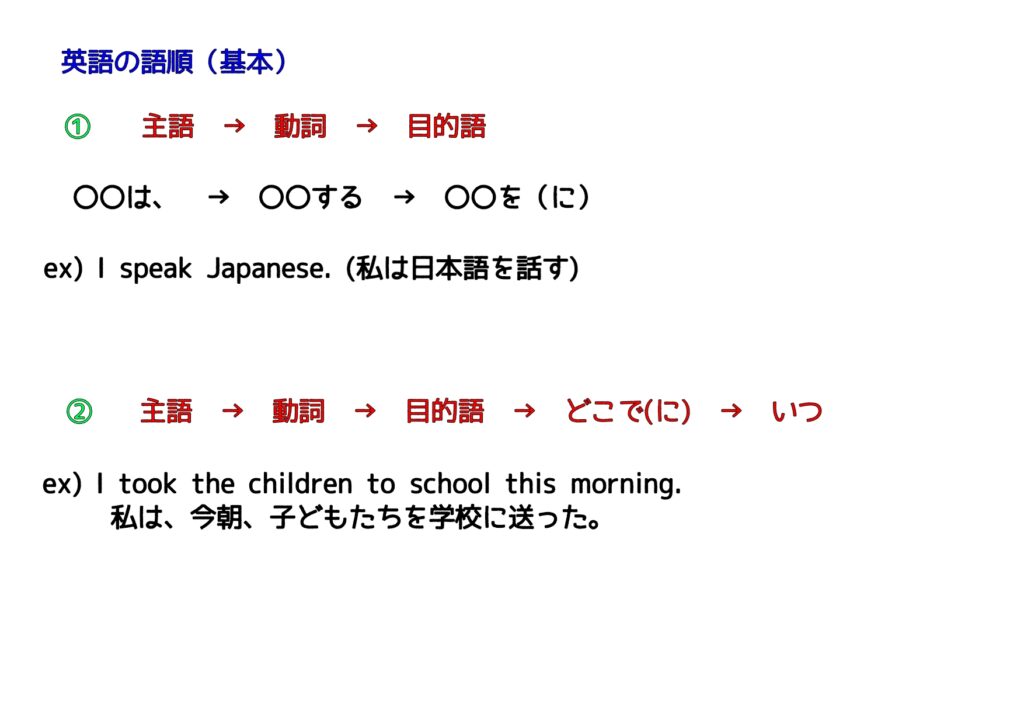第76回:場所・方向・頻度・時を表す副詞

準否定語の使い方も含めて確認を進めてみましょう。
Q. この記事で、一番大事なことって何?
A. 大事なことを、1枚の画像にまとめました。

いちいちノートにまとめるのが面倒だという方、また、
ノートにまとめることが苦手だという方は、ご活用ください。

[広告]
確かな英語力は、日々の継続から。
その継続を後押しする、第二言語習得理論に基づいた
オンライン英語学習プログラムがあります。
英語を使う人のための、確実なスキルアップが望める
7日間の無料体験はこちらから!

場所・方向を表す副詞の位置
副詞の中でも、場所や方向を示す副詞(または副詞句、特に前置詞句)は通常、終わりの位置に配置されますが、場所を強調するために前置位置に配置することもあります。この順序は、主に形容的な文章や報告書で見られます。
- The money was eventually found under the floorboards(お金は最終的に床板の下で見つかりました)(=終わりの位置)
- The police searched the house. Under the floorboards they found a body(警察は家を捜索しました。床板の下で彼らは死体を見つけました)(=前置位置)
場所の副詞を前置位置に配置する場合、be動詞の後に主語を配置します。
例:Next to the bookshelf was a fireplace(本棚の隣には暖炉がありました)(またはより非公式に Next to the bookshelf there was a fireplace)(ただし Next to the bookshelf a fireplace wasではなく)。
また、位置や移動を示す自動詞(ただし代名詞の主語ではない場合)では、動詞の後に主語を配置することもできます。
例:Beyond the houses lay open fields(家の向こうに広がるのは広々とした野原でした)(ただし Beyond the houses they layではなく)。
その他自動詞:hang, live, sit, stand; come, fly, go, march, roll, run, swim, walk
注:… open fields lay’ は文学的なスタイルで使われることがあります。
ただし、行動について話す場合、これらの自動詞のいずれかが「方法」(どのようにを表す副詞)で修飾されている場合、他の自動詞である場合、または他動詞である場合は、動詞の後に主語を配置することは通常ありません。
例:Through the waves the boy swam powerfully(波を抜けて少年は力強く泳ぎました)(rather than swam the boy powerfully)。
例:Outside the church the choir sang(教会の外で合唱団が歌いました)(rather than … sang the choir)。
例:In the garden Nik built a playhouse for the children(庭でニクは子供たちのために遊び場を建てました)(not in the garden built Nik …)。
- 時間を示す特定の副詞を前置位置に配置する場合、主語は助動詞またはbe動詞の後に配置する必要があります。
例:At no time would he admit that his team played badly(彼はいかなる時も彼のチームが悪くプレーしたとは認めませんでした)(not At no time he would admit…)。
例:Not once was she at home when I phoned(私が電話をしたとき、彼女は一度も家にいませんでした)(not Not once she was…)。
ただし、主要な動詞がbe動詞ではなく補助動詞もない場合は、doを使用します。ただし、この場合は倒置は必要ありません。
例:Only later did she realize how much damage had been caused(後で彼女はどれだけのダメージが引き起こされたかを理解しました)(または Only later she realized…)。
このような副詞には、at no time、hardly ever、not once、only later、rarely、seldomなどの否定的な時間副詞も含まれます。また、新しい出来事を導入するために、come動詞の前にfirst、next、now、thenを前置位置に配置することもできますが、first(など)の後にカンマ(または話し言葉ではイントネーションの休止)が使われる場合は、動詞が主語の後に続きます。
例:At first there was silence. Then came a voice that I knew(最初は沈黙がありました。それから、私が知っている声が現れました)(not Then a voice came…)。
例:At first there was silence. Then, a voice came that I knew(最初は沈黙がありました。それから、私が知っている声が現れました)。
- 特定の時間を示す副詞は、通常は終わりの位置に配置されますが、強調のために前置位置に配置することもあります。ただし、中間位置には配置しません。これらの副詞が前置位置にある場合、主語と動詞の倒置はありません。
例:I went to Paris yesterday(昨日、私はパリに行きました)(または Yesterday I went to Paris)。
例:We meet for lunch once a week(私たちは週に一度昼食をとります)(または Once a week we meet for lunch)。
また、daily、hourly、monthly、weekly、annually、quarterly(四半期ごと)などの副詞は、終わりの位置に配置されます。
例:I pay my subscription annually(私は年に一度会費を支払います)(not Annually I pay…)。
副詞の適切な位置は、文の意味を明確に伝え、スタイルを明確にするために重要です。正確な位置の選択には注意が必要です。
具体例
- Adverbs of place and direction:
- End position: She placed the keys on the table.
- Front position: On the table, she placed the keys, revealing a hidden note underneath.
- Adverbs of time in front position:
- Auxiliary verb: Never before had he witnessed such a breathtaking sunset.
- Main verb: Always, she brings a smile to everyone’s face.
- Adverbs of time indicating definite frequency:
- End position: They go hiking in the mountains annually.
- Front position (for emphasis): Annually, they embark on an adventurous journey through the majestic mountains.
- Adverbs of time indicating definite points or periods:
- End position: They celebrated their anniversary yesterday.
- Front position: Yesterday, they joyfully celebrated their anniversary.
- Adverbs of time with specific adverbials:
- End position: He attends piano lessons weekly.
- Front position: Weekly, he dedicates himself to improving his piano skills.
[広告]
TOEICのスコアを上げたいけれど、
まとまった勉強時間が取れなくて困っている…
なら、細かいスキマの時間を使いながら、
少しずつスキルを積み重ねてみてはどうでしょう。
スマホ1つでスコアアップが出来る、
オンライン講座のリンクはこちらから。

Q. この文法はどうやって使うのでしょうか?
A. 今回の文法を活用した会話文を見てみましょう。

Have you seen my keys?
(私の鍵、見かけなかった?)

Under the floorboards, I found them.
(床下の隙間から見つけたよ。)

Wait, you found my keys under the floorboards?
(えっ、床下で鍵を見つけたの?)

Yes, that’s where they were hiding.
(そう、そこに隠れていたんだ。)

Unbelievable! How did they end up there?
(信じられない!どうやってそこに入ってしまったの?)

It’s hard to say. They must have slipped through a crack or something.
(はっきりとはわからないけど、隙間から滑り込んだのかもしれないよ。)

Well, I’m glad you found them. Next time, I’ll make sure to keep them in a safer place.
(まぁ、見つかってよかった。次はもっと安全な場所に置いておくようにするね。)

Definitely, it’s important to keep track of your keys.
(そうだね。鍵を大切に管理することは大事だね。)
[広告]
ロゼッタストーン・ラーニングセンターで、最先端の教育制度を活用して英語を学びませんか?私たちは個々の学習ペースに合わせてeラーニングと対面教育を組み合わせ、柔軟な学習環境を提供しています。自宅でのeラーニングと対面教育のメリットを最大限に活かし、あなたの英語学習をサポートします。最新のテクノロジーと個別の指導が組み合わさった当センターで、自由な学習スタイルを体験してみませんか?英語学習を楽しく効果的に進めるための環境がここにあります。新たな一歩を踏み出して、新しい英語学習の旅に参加しましょう!

Q. この記事の要点は?
A. 副詞を使った際の語順等も確認しました。
Adverbs of place, direction, indefinite frequency, and time:
- Adverbs of place and direction:
- Usually placed in end position.
- Can be placed in front position for emphasis or to highlight what comes at the end.
- When in front position, subject comes after the verb “be” or with certain intransitive verbs indicating position or movement.
- Adverbs of time in front position:
- Subject must come after an auxiliary verb or the main verb “be”.
- Use of “do” as an auxiliary is required if the main verb is not “be” and there is no auxiliary.
- Certain adverbs like “at no time,” “hardly ever,” “not once,” “only later,” “rarely,” and “seldom” fall into this category.
- Adverbs of time indicating definite points or periods:
- Usually placed in end position, or front position for emphasis.
- No inversion of subject and verb when these adverbs are in front position.
- Adverbs like “daily,” “hourly,” “monthly,” “weekly,” “annually,” etc., only go in end position.
Note: Exceptions and variations exist depending on the specific adverb and sentence structure.
英会話を始めてみたいけれど、どのサービスが良いか分からない…
そんな方は、まず、この記事で3つのサービスを比べてみてはいかがでしょうか?
英語力を効率良く伸ばすことができるサービス3選です。

次回の文法解説は?
程度を表す副詞。相手の注意を引くための副詞。
この記事を作る際に参考にした文法の解説書になります。
すべて英語で書かれていますが、練習問題が付いてます。
イギリス英語なので、スペル等の表記が異なる部分もありますが、
「使い方を練習したい」「繰り返し問題を解きたい」
という方は、使ってみても良いかもしれません。

関連記事一覧
他の文法解説記事を検索できます。







-320x180.jpg)





コメント